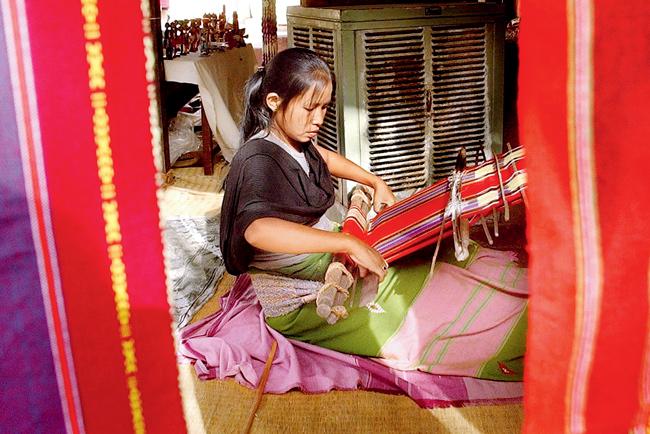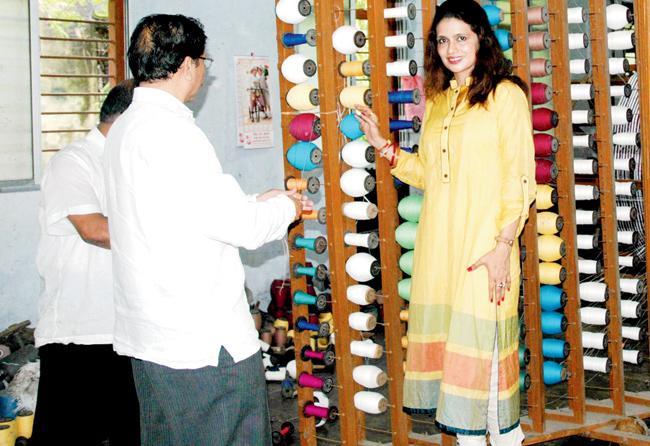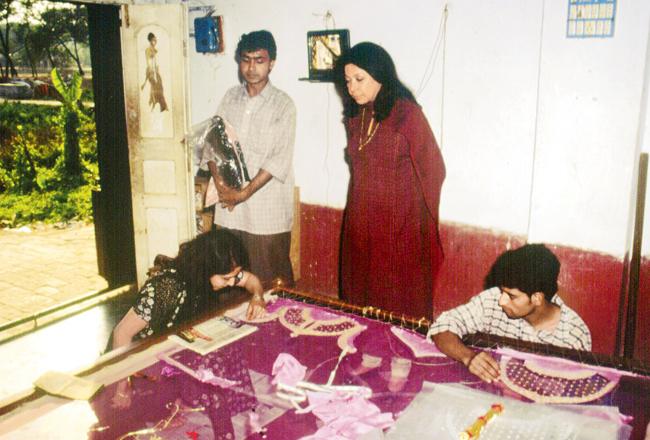Recently, the Union Government announced Skill India to improve the status of India’s weavers. the guide asks designers whether this initiative will improve the weavers' socio-economic condition

Indian weavers, Shruti Sancheti, Skill India, Union Government initiative
Weavers, weaving at break of day,
Why do you weave a garment so gay?
Blue as the wing of a halcyon wild,
We weave the robes of a new-born child.
ADVERTISEMENT

A weaver drying silk threads, which will be used to weave a traditional silk sari in Kancheepuram, around 85 km southwest of Chennai. Pic/AFP
Indian national leader and poet Sarojini Naidu tried to instill the importance of weaving effortlessly through these lines from her poem, Indian Weavers. She stressed on their contribution as they painstakingly create meters of beautiful tradition for us, whether at daybreak or by burning the midnight oil.

The weavers in the North-East have been facing survival issues and need support to keep the textile tradition alive. Seen here, a woman from Assam weaving on a lion-loom. Pic/AFP
Today, the weaver community is finding it hard to survive and carry on with their lineage soaked in rich crafts. In a promising move, the Central Government recently announced the launch of a national multi-skill programme, Skill India, during the Union Budget. The programme aims at providing training and support for traditional professions like weaving. While the period of implementation has not been announced, the intention translates into a ray of hope for designers, who work hand-in-hand with the members of this community.

Designer Shruti Sancheti often works with weavers from different parts of Maharashtra for her collections
“This will give huge encouragement to indigenous craftsmen. The vast resource of weaving, hand spinning and textile craft will bring back employment to the rural poor and give a cash component to add to the agrarian income of most of these communities,” says Delhi-based designer Ritu Kumar.

Designer Ritu Kumar, quoted here, has been at the forefront of creating opportunities for Indian weavers, and has even won a National Award for her work in this field
Shruti Sancheti, a designer from Mumbai, concurs with Kumar’s opinion and sees Skill India as an opening of doors for infinite opportunities. “India has an unsurpassed legacy of weaves and crafts, and these programmes will benefit weavers where their skills will be nurtured and honed. It will also provide a platform for revival of forgotten and ancient weaves,” she shares.
More the better
However, a few other designers, while lauding the intention of the programme, believe that only training weavers will not elevate their fortunes. “What needs to be done is to retain the youth in the craft,” says designer Anavila Misra, suggesting that that will ensure the continuation of the weaving legacy.
Bright spark on the fashion scene, Rahul Mishra, reiterates that India’s weavers are already an extremely skilled workforce, but need a push across other spheres. “We must create a market for them if we wish to improve their condition. Unless they are aware of these avenues, will they have the confidence to stick to what they are best at?” he questions.
Mishra opines that since modernity in design has become crucial in India, weavers too need a vision — to create a product that appeals to people across walks of life. “Designers should get on board as consultants, to share design tips with weavers so as to visualise a creative and contemporary fabric, thereby ensuring more takers,” he explains.
Road ahead
Jaya Jaitly, president of the Dastkari Haat Samiti and former politician, reminds that realistic and flexible programmes should be devised. “The current ones allow corruption and do not help the participating craftsmen. Better design inputs and product development, short-term loans for production, marketing avenues like local markets and haats, and some reasonable publicity to compete with industrialised goods, will help,” she shares.
Soumitra Mondal has been working with West Bengal’s weavers, and owns a handloom-based textile company, Bunon Textile that employs 300 weavers. Having been at ground zero, he feels that all the 29 state governments should promote their own crafts, weaving and artisans using retail chains. “If all the state governments open at least 200 retail chains, India will get 5,800 retail chains in the hand-crafted sector,” he sums up.
 Subscribe today by clicking the link and stay updated with the latest news!" Click here!
Subscribe today by clicking the link and stay updated with the latest news!" Click here!






